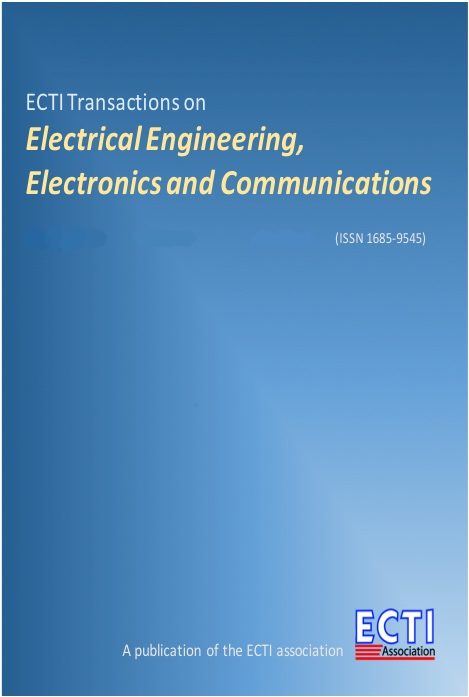Optimizing Wi-Fi RSSI and Channel Assignments Using a Genetic Algorithm for Wi-Fi Tuning
Main Article Content
Abstract
In this work, we propose a genetic algorithm-based Wi-Fi-tuning platform to facilitate network administrators in coping with the co-channel interference triggered by other wireless sources. Generally, with a well-designed WLAN, signal interference from adjacent areas is usually minimal. Unfortunately, when other wireless sources are introduced into the WLAN system, co-channel interference is inevitable. Interference usually causes degradation and/or disruption in network services. Resolving this issue becomes even more complicated when the interfering signals come from access points owned by other ISPs and are not accessible by the network administrators. This paper proposes a Wi-Fi tuning platform that allows the automatic reconfiguration of WLAN settings by finding the best settings for channel assignment and power transmission. When signal interference is detected, the platform attempts to find heuristic solutions for wireless settings based on a genetic algorithm. Our experiments show that the proposed algorithm can regenerate the WLAN settings, providing stronger signal levels and higher coverage ranges while reducing interference levels in the deployment area. With the proposed platform, troubleshooting becomes less complicated, requiring less cost and time. With the help of the Wi-Fi tuning platform, network administrators can react promptly to incidents, enhancing the availability, reliability, and consistency of the WLAN system.
Article Details
This journal provides immediate open access to its content on the principle that making research freely available to the public supports a greater global exchange of knowledge.
- Creative Commons Copyright License
The journal allows readers to download and share all published articles as long as they properly cite such articles; however, they cannot change them or use them commercially. This is classified as CC BY-NC-ND for the creative commons license.
- Retention of Copyright and Publishing Rights
The journal allows the authors of the published articles to hold copyrights and publishing rights without restrictions.
References
S. Liu, C. Zhong, L. Zhang, and L. Zhang, “Optimization Design of Wireless Local Area Network Based on Improved Adaptive Genetic Algorithm,” in 2006 6th World Congress on Intelligent Control and Automation, 2006, pp. 3357–3360.
E. Agustin-Blas, S. Salcedo-Sanz, P. Vidales, G. Urueta, A. Portilla-Figueras, and M. Solarski, “A Hybrid Grouping Genetic Algorithm for citywide ubiquitous Wi-Fi access deployment,” in 2009 IEEE Congress on Evolutionary Computation, 2009, pp. 2172–2179.
Z. Zhang, X. Di, J. Tian, and Z. Zhu, “A multi-objective WLAN planning method,” in 2017 International Conference on Information Networking (ICOIN), 2017, pp. 86–91.
T. Vanhatupa, M. Hannikainen, and T. D. Hamalainen, “Genetic Algorithm to Optimize Node Placement and Configuration for WLAN Planning,” in 2007 4th International Symposium on Wireless Communication Systems, 2007, pp. 612–616.
S. Qiu, X. Chu, Y. -W. Leung, and J. K. Yin Ng, “Joint Access Point Placement and Power-Channel-Resource-Unit Assignment for 802.11ax-Based Dense Wi-Fi with QoS Requirements,” in IEEE Conference on Computer Communications, 2020, pp. 2569–2578.
A. Raschellà, M. Mackay, F. Bouhafs, and B. I. Teigen, “Evaluation of Channel Assignment Algorithms in a Dense Real World WLAN,” in 2019 4th International Conference on Computing, Communications and Security, 2019, pp. 1–5.
A. Baid and D. Raychaudhuri, “Understanding channel selection dynamics in dense Wi-Fi networks,” IEEE Communications Magazine, vol. 53, no. 1, pp. 110–117, Jan. 2015
F. Maturi, F. Gringoli, and R. Lo Cigno, “A dynamic and autonomous channel selection strategy for interference avoidance in 802.11,” in 2017 13th Annual Conference on Wireless Ondemand Network Systems and Services, 2017, pp. 1–8.
A. Valkanis, A. Iossifides, and P. Chatzimisios, “An interference based dynamic channel access algorithm for dense WLAN deployments,” in 2017 Panhellenic Conference on Electronics and Telecommunications, 2017, pp. 1–4.
M. Seyedebrahimi, F. Bouhafs, A. Raschellà, M. Mackay and Q. Shi, “SDN-based channel assignment algorithm for interference management in dense Wi-Fi networks,” in 2016 European Conference on Networks and Communications, 2016, pp. 128–132.
V. Bhargava and N. S. Raghava, “Improve Collision in Highly Dense Wi-Fi Environment,” in 2018 2nd IEEE International Conference on Power Electronics, Intelligent Control and Energy Systems, 2018, pp. 1–5.
K. Fertas, H. Kimouche, M. Challal, H. Aksas, and R. Aksas, “An optimized shaped antenna for multiband applications using Genetic Algorithm,” in 2015 4th International Conference on Electrical Engineering, 2015, pp. 1–4.
M. C. Derbal, A. Zeghdoud, and M. Nedil, “A Novel Dual Band Antenna Design for Wi-Fi Applications Using Genetic Algorithms,” in 2018 IEEE International Symposium on Antennas and Propagation, 2018, pp. 1009–1010.
K. He and G. Yu, “Genetic Algorithm for Balancing Wi-Fi and LTE Coexistence in the Unlicensed Spectrum,” in 2016 IEEE 83rd Vehicular Technology Conference, 2016, pp. 1–5.
A. Goldsmith, Wireless Communications. Cambridge, U.K.:Cambridge University Press, 2005, pp.45–46.
A. Apavatjrut and E. Boonyasiwapong, “Indoor WIFI localization on embedded systems,” in Information Science and Applications (Lecture Notes in Electrical Engineering, vol. 339), K. Kim, Ed. Berlin, Germany: Springer, 2015, pp. 59–66.
W. Sangkusolwong and A. Apavatjrut, “Indoor Wi-Fi Signal Prediction Using Modelized Heat Map Generator Tool,” in 21st International Computer Science and Engineering Conference, 2017, pp. 1–5.


